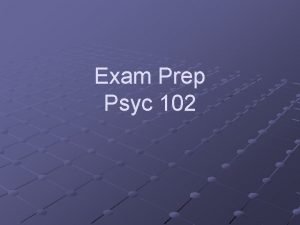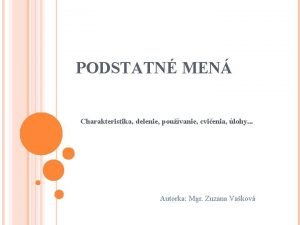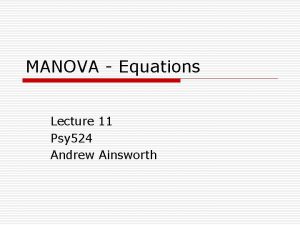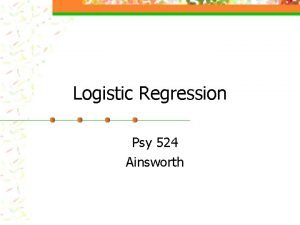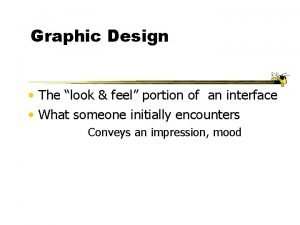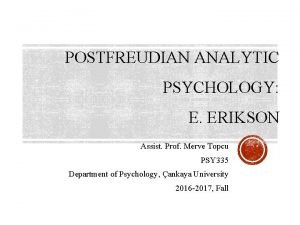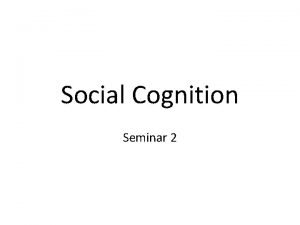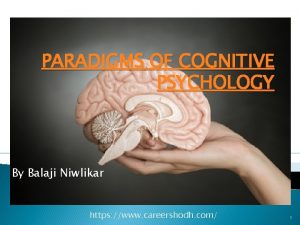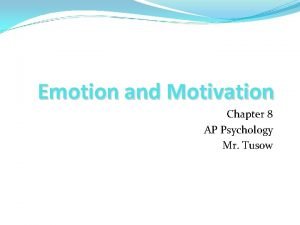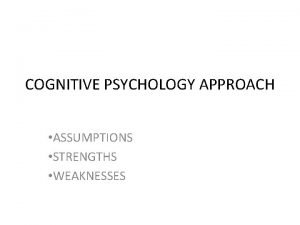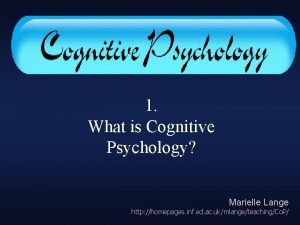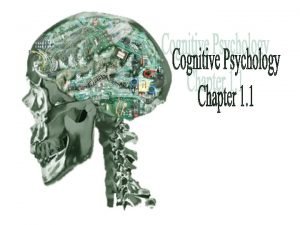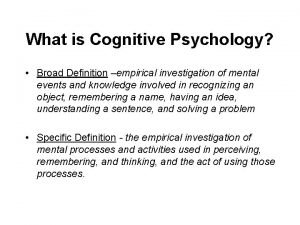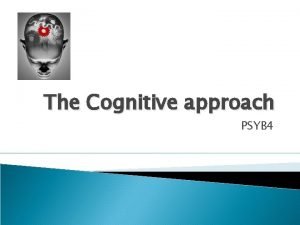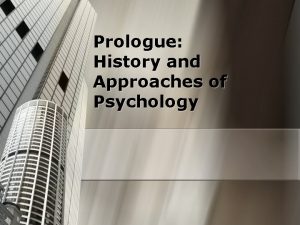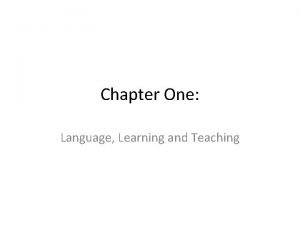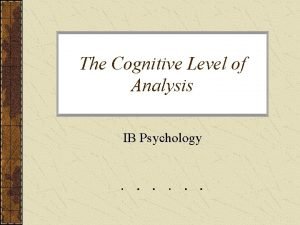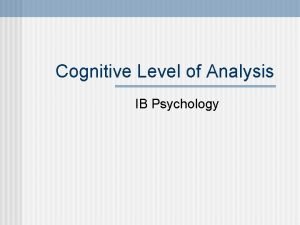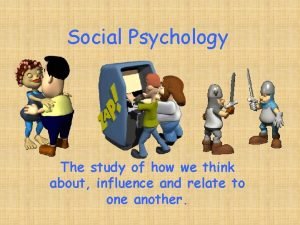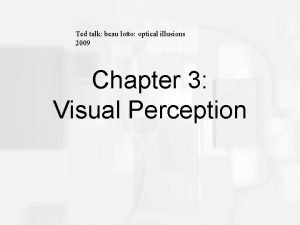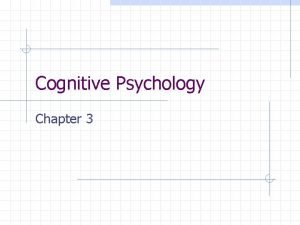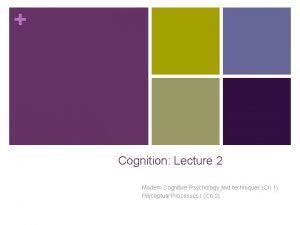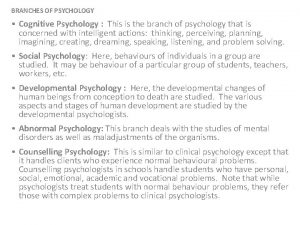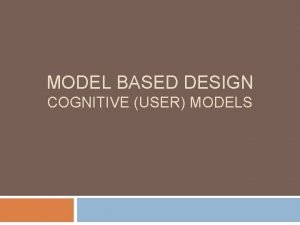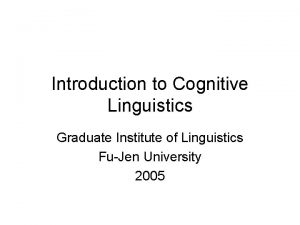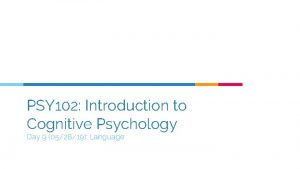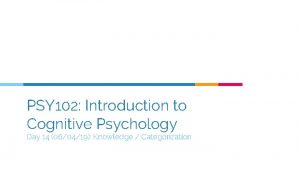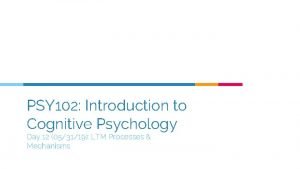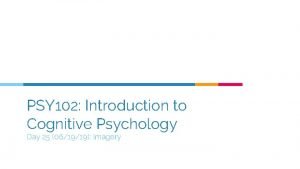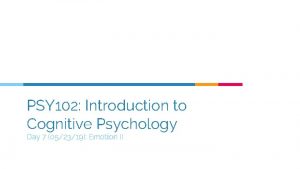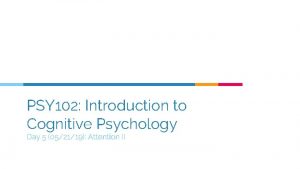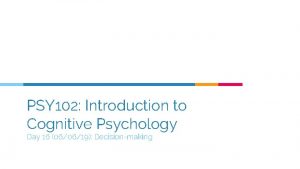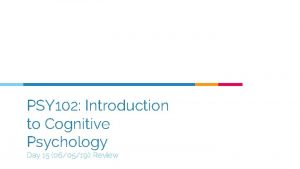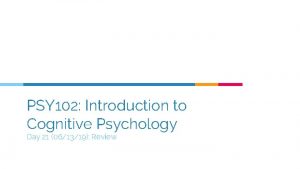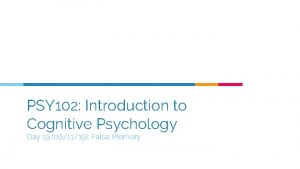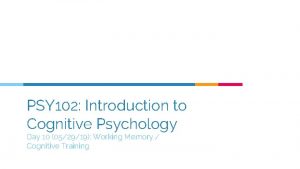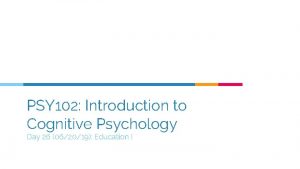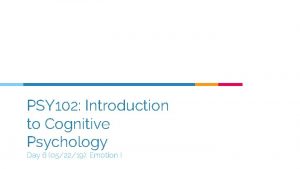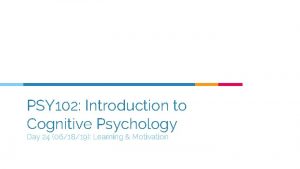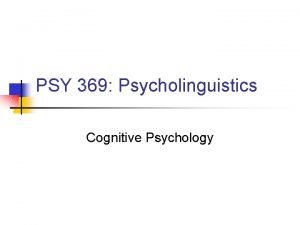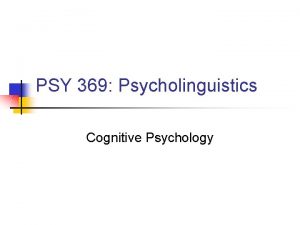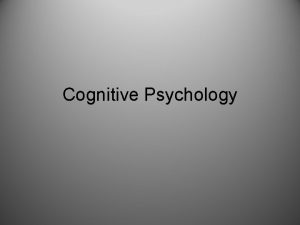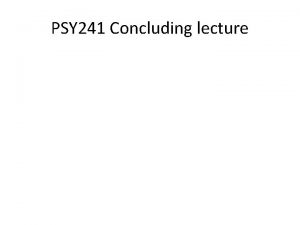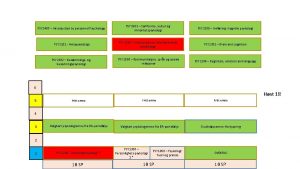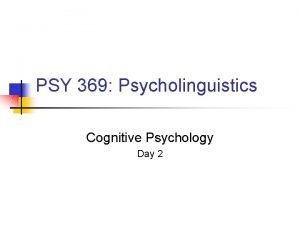PSY 102 Introduction to Cognitive Psychology Day 17






























































- Slides: 62

PSY 102: Introduction to Cognitive Psychology Day 17 (06/07/19): Motivated reasoning

Today’s Goals + Agenda 1. LO 1: Continue to build a supportive classroom culture & discuss science communication. ○ How does the media cover research on motivated reasoning et al. ? ○ What do these papers mean in terms of how we would communicate controversial science? We will reconsider this in sum on Monday. 2. LO 2: Define, identify, and apply previous constructs that we have discussed in class ○ Quiz on material covered since the last quiz: multiple choice & short answer 3. LO 3: Describe the basic fundamental principles underlying human judgment & connect to our critical analysis of journal articles. ○ Describe basic research on motivated reasoning, inductive reasoning, representativeness heuristic, availability heuristic, conjunction rule, confirmation bias, law of large numbers, peak-end effect & loss aversion, etc. , ○ How does this research impact our approach to the scientific method & open science? ○ What does this research suggest about how we can change people's minds?

Monday’s Work ○ Read Levari et al. (2018) (prevalence-induced concept change) ○ Optional reading: Klein & O’Brien (2018) (amnt of information we use in making decisions) ○ Comic: Believe! (on backfire effect) ○ Podcast: Active Information Avoidance ○ Outline on Duke Research Blog Theme: What are some other cognitive biases that affect our reasoning and decision-making, and how does this impact science communication?

Today’s themes 1. How do people make judgements? 2. Can you change people’s minds?

Judgment & Decision-Making ▷ Inductive reasoning : drawing a conclusion based on evidence from observations ○ Conclusions are “probably true” (not definitely ) ○ Often uses memory

Inductive Reasoning Observation: All the crows I’ve seen in Pittsburgh are totally black. When I visited my brother in Washington, DC, the crows I saw there were black too. Conclusion: I think it is a pretty good bet that all crows are black.

What makes for a good inductive argument? ▷ Representativeness of observations ○ (e. g. , WEIRD samples - not great) ▷ Number of observations ○ (e. g. , sample size) ▷ Quality of the evidence Predictions on what will happen based on what has happened in the past.

Heuristics “Rules of thumb” that are likely to provide the correct answer to a problem, but are not foolproof Heuristics: not always terrible! (But sometimes terrible)

______ Heuristic ▷ “Which are more prevalent in English, words that begin with the letter R or words in which R is the third letter? ”

______ Heuristic Some possible causes of death are listed below in pairs. Within each pair, which cause of death do you consider to be more likely for people in the United States? That is, if you randomly picked someone in the United States, would that person be more likely to die next year from cause A or cause B? Cause A: 1. 2. 3. 4. 5. Homicide Auto-train collision Botulism Asthma Appendicitis Cause B: 1. 2. 3. 4. 5. Appendicitis Drowning Asthma Tornado Pregnancy

Availability Heuristic ▷ “Which are more prevalent in English, words that begin with the letter R or words in which R is the third letter? ” ▷ ▷ ▷ Easier to bring words that begin with R to mind Conclusion: more words begin with R In reality, >3 x more words have R in the third position

Availability Heuristic

Availability Heuristic ▷ Information (or events) that is more easily remembered is judged as being more probable than events information (or events) are less easily remembered ▷ Social media pictures ○ easily available, easily remembered Conclusion: my friends are doing fun, fulfilling things more frequently than they really are ▷

Availability Heuristic ▷ ▷ ▷ Illusory correlation: association between variables “seemingly” exists, but doesn’t or is pretty weak Pop culture in media makes things more available Stereotypes ○ Oversimplified generalizations about a group or class of people ○ Often focuses on the negative ○ If mediated by pop culture at all, the availability heuristic can create a stereotype that does not map onto reality (“all members of this group are ___”)

Random Dude from N. C. Jack is a 45 -year-old man. He is married and has four children. He is generally conservative, careful, and ambitious. He shows no interest in political and social issues and spends most of his free time on his many hobbies, which include home carpentry, sailing, and mathematical puzzles. What’s the likelihood that Jack is a lawyer or engineer?

Representativeness Heuristic ▷ ▷ In a group of 100 people, there are 70 lawyers and 30 engineers. What’s the chance that if you pick one person from the group at random that the person will be an engineer? Jack is in this group. Would you change your estimate?

Representativeness Heuristic ▷ Heuristic: “Probability that A is a member of class B can be determined by how well the properties of A resemble the properties we usually associate with class B” ○ Base rate: Relative proportion of different classes in the population (70: 100 for lawyers; 30: 100 engineers) When descriptive information is available, people don’t think about the base rate to make their estimates. ▷ Not always bad; descriptive information is still useful.

Linda is 31 years old, single, outspoken, and very bright. She majored in philosophy. As a student, she was deeply concerned with issues of discrimination and social justice, and also participated in antinuclear demonstrations. Which of the following alternatives is more probable? 1. Linda is a bank teller. 2. Linda is a bank teller and is active in the feminist movement.

Conjunction Rule Probability of 2 events cannot be higher than the probability of each single event, yet most people pick #2 Linda is 31 years old, single, outspoken, and very bright. She majored in philosophy. As a student, she was deeply concerned with issues of discrimination and social justice, and also participated in antinuclear demonstrations. Which of the following alternatives is more probable? 1. Linda is a bank teller. 2. Linda is a bank teller and is active in the feminist movement.

Male & Female Births A certain town is served by two hospitals. In the larger hospital about 45 babies are born each day, and in the smaller hospital about 15 babies are born each day. As you know, about 50 percent of all babies are boys. However, the exact percentage varies from day to day. Sometimes it may be higher than 50 percent, sometimes lower. For a period of 1 year, each hospital recorded the days on which more than 60 percent of the babies born were boys. Which hospital do you think recorded more such days? ▷ ▷ ▷ The larger hospital? The smaller hospital? About the same

Errors happen when you assume a small number of folks accurately represent the population ▷ Law of large numbers : the larger the number of individuals randomly drawn from a population, the more representative the resulting group will be of the entire population ○ Samples of small numbers of individuals will be less representative. ○ So, in the large hospital, should be closer to 50%, but much farther away from 50% in the small hospital (i. e. , right answer is small hospital)

How to Not Do Science ▷ Confirmation bias : tendency to selectively look for information that conforms to our hypothesis and overlook information that argues against it (like a pair of “blinders”) ○ Myside bias: tendency for people to generate and evaluate evidence and test their hypotheses in a way that is biased toward their own opinions and attitudes ○ Confirmation bias is any situation where you are unknowingly trying to confirm; myside bias is a subset of that

Myside Bias ▷ Lord and coworkers (1979) ○ Had those in favor of capital punishment and those against it read the same article ■ Those in favor found the article convincing ■ Those against found the article unconvincing

Anchoring Heuristic ▷ When faced with an estimation task… ○ Use prior knowledge as an anchor (even if you just got it) - i. e. , a reference point ○ Adjust away ○ (It’s usually an insufficient adjustment, so initial anchor makes a BIG difference)

Peak-End Effect

Peak-End Effect ▷ You judge an experience based largely on how you feel at its peak and its end rather than a sum or average of every moment

Loss Aversion ▷ ▷ Tendency to avoid losses rather than acquire gains Remember our scenario on Program A/B/C/D and the certainty of people dying? → So many other heuristics… see: GI-Joe Fallacy, Pricing Biases, Mental Accounting, Alief, etc.

Our judgments about risk are also weird If Program A is adopted, 200 people will be saved. If Program B is adopted, there is a 1/3 probability that 600 people will be saved, and a 2/3 probability that no one will be saved. ▷ ▷ 72% wanted to go with Program A (definite strategy (risk aversion)). ● ▷ ▷ If Program C is adopted, 400 people will die. If Program D is adopted, there is a 1/3 probability that nobody will die, and a 2/3 probability that 600 people will die. 78% wanted to go with Program D (risky strategy (risk-taking)). Framing effect : decisions are influenced by how the choices are framed ○ When choices are framed in terms of gains, people tend to be risk-averse ○ When choices are framed in terms of losses, people tend to be risk-taking

Loss Aversion ▷ ▷ Tendency to avoid losses rather than acquire gains Tendency to choose Program A/D over Program B/C is not just about framing. It’s also that we have loss aversion. So many other heuristics… see: GI-Joe Fallacy, Pricing Biases, Mental Accounting, Alief, etc.

Can we change people’s minds?

Day 1: More Information Isn’t Enough (cc: Nyhan et al. (2014), Pediatrics )

Podcast: I’m Right, You’re Wrong ▷ How does the media cover this topic, knowing that data is not enough? ▷ How do you change minds? ▷ What are some other factors that impact our decision-making, per the podcast?

Podcast: I’m Right, You’re Wrong ▷ “There's four factors that determine whether we're going to change our beliefs - our old belief, our confidence in that old belief, the new piece of data and our confidence in that piece of data. And the further away the piece of data is from what you already believe, the less likely it is to change your belief. ” ○ Remember Perception (Day 3 + Review on Day 8)? ○ Remember Bayesian updating of priors? Coupling of minds -- sound familiar (shared attention, Day 4)? Everything from the 1 st half of the course will be applied to everything in the 2 nd half of the course. . .

Can you change people’s political opinions with reasoning? Stanley et al. (2019) ▷ ▷ ▷ How did they test this? If you had to give a one-sentence summary of figures & overall of the paper, what would you say? What do you want to know more about & what were limitations ○ Take the next 5 min to discuss with the other folks in the class near you & refresh your memory of the article

Fracking is a process by which natural gas is extracted from reservoirs below the Earth’s surface. As part of the fracking processing, chemicals, sand, and water are injected into rock at high pressure, allowing gas from below to flow above the surface of the rock, where it is then collected. Fracking is a currently a contentious issue in the United States. Some people support fracking in the United States, and other people do not support fracking in the United States. The United States economy used to operate on a gold standard, meaning that the value of currency was backed by gold reserves. In 1971, however, the United States abandoned the gold standard, handing the government full responsibility and control over the dollar. There is currently debate over whether the United States should return to the gold standard. There are several reasons one might support the United States returning to a gold standard, and there are several reasons one might oppose the United States returning to a gold standard.

Stanley et al. (2019) Q 1: How likely are people to change their positions about socio-political issues after evaluating different sets of reasons?

Stanley et al. (2019) Q 2: For those who don’t change their position, do they evaluate the reasons available to them in a biased way, favoring those that back their initial choice? -> does prior knowledge or reason novelty matter? -> what about the people who reported not making decisions based on any reasons?

Stanley et al (2019) Both sides Q 3: Do those who stick with their initial positions after evaluating reasons become more confident in the superiority of their positions after considering reasons? Conflicting only Affirming only

Is misinformation driven by political motivated reasoning? Pennycook & Rand (2018) ▷ How did they test this? What did they find? What do you want to know more about, & what were limitations? ○ Take the next 5 min to discuss with the other folks in the class near you & refresh your memory of the article







Pennycook & Rand (2018)

Pennycook & Rand (2018) ▷ What differed in Studies 2 and 3? ▷ How could you motivate people to change their beliefs? (A bit of a stretch here).

Quiz Define, identify, and apply previous constructs that we have discussed in class

Today’s Goals + Agenda 1. LO 1: Continue to build a supportive classroom culture & discuss science communication. ○ How does the media cover research on motivated reasoning? ○ What do these papers mean in terms of how we would communicate controversial science? We will reconsider this in sum on Monday. 2. LO 2: Define, identify, and apply previous constructs that we have discussed in class ○ Quiz on material covered since the last quiz: multiple choice & short answer 3. LO 3: Describe the basic fundamental principles underlying human judgment & connect to our critical analysis of journal articles. ○ Describe basic research on motivated reasoning, inductive reasoning, representativeness heuristic, availability heuristic, conjunction rule, confirmation bias, law of large numbers, peak-end effect & loss aversion, etc. , ○ How does this research impact our approach to the scientific method & open science? ○ What does this research suggest about how we can change people's minds?

Participation + Minute Paper https: //tinyurl. com/PSY 102 Participation https: //tinyurl. com/PSY 102 Minute. Paper. June 7

Additional Practice Optional: Test Yourself

So… what are heuristics? ▷ Which is closest to the truth? ○ Heuristics inevitably mislead you during decisionmaking ○ Heuristics are cognitive shortcuts that are both optimal in the long run and virtually always true for a given instance ○ Heuristics are cognitive shortcuts that are optimal in the long run but sometimes mislead you during decision-making

Name the Error in Judgment 1. Events that are more easily remembered as judged as more probable 2. Strong correlation between two events appears to exist, but doesn’t. 3. Probability that A is a member of class B is determined by how well properties of A resemble properties usually associated with B. 4. Relative proportions of different classes in the population. 5. Probability of conjunction of two events (A and B) cannot be higher than the probability of single constituents. 6. The larger the number of individuals drawn from a population, the more representative the group will be of the entire population. 7. Tendency for people to generate and evaluate evidence and test their hypotheses in a way that is biased towards their own opinions & attitudes 8. Selectively looking for information that conforms to a hypothesis and overlooking information that argues against it.

When do errors occur? When. . 1. 2. 3. 4. 5. 6. Easily remembered event is less probable There is no correlation, or it is weaker than it appears to be. Presence of similar properties doesn’t predict membership in class B. Base rate information is not taken into account. Higher probability is assigned to the conjunction. It is assumed that a small number of individuals accurately represents the entire population. 7. People let their own opinions and attitudes influence how they evaluate evidence needed to make decisions. 8. There is a narrow focus only on confirming information.

Consider the following argument: Observation: Here in Nashville, the sun has risen every morning. Conclusion: The sun is going to rise in Nashville tomorrow. A. The argument is weak because there is only one specific case B. The argument is strong because the premise includes scientific evidence C. The argument is weak because the observation does not consider other cities. D. The argument is strong because there a large number of observations.

At a lunch meeting with a client, the CEO of Gossip Polls, Inc. , was asked to determine America's favorite day of the week. Hundreds of Gossip employees across the U. S. started collecting data immediately, calling people at their residences. One hour later, the attitudes from 10, 000 Americans, across all 50 states, were collected. A staff member called the CEO, still at her lunch meeting, to tell her the results of the poll: America's favorite day of the week is Monday. Given our inductive reasoning in science, we might suspect that the observations in this poll are not representative because A. The participants were only asked one question for this poll B. The participants were not sufficiently geographically diverse C. The people who are home to answer the phone in the early afternoon are not an appropriate cross-section of the U. S. population D. Everyone in America was not asked their opinion

Derrick purchased a new car, a Ford Mustang, less than a month ago. While sitting in traffic, Derrick says to his girlfriend, "Mustangs must be the best-selling car now. I can't remember seeing as many on the road as I have recently. " Derrick's judgment is most likely biased by a(n) A. B. C. D. Representativeness heuristic Availability heuristic Illusory correlation Permission Schema

Jonas bought a new leather jacket after saving for many months for the luxury purchase. On the first day he went out wearing the new garment, he found a $50 bill on the sidewalk outside of his office. He now refers to the jacket as his “lucky jacket” and believes that it has some magical power to give him good fortune. Jonas's belief in the jacket's cosmic ability is an example of A. B. C. D. The availability heuristic An illusory correlation Selective attention The falsification principle

One hundred students are enrolled in State University's course on introductory physics for math and science majors. In the group, 60 students are math majors and 40 are science majors. Sarah is in the class. She got all As in her high school science courses, and she would like to be a chemist someday. She lives on campus. Her boyfriend is also in the class. There is a ____ chance that Sarah is a science major. A. B. C. D. 40% 50% 60% 100%

Lydia is 48 years old, single, outspoken, and very bright. She majored in philosophy as an undergraduate. As a student, she was deeply concerned with issues of discrimination and social justice, and she participated in anti-nuclear demonstrations. Which of the following alternatives is most probable? A. Lydia is a U. S. Congresswoman B. Lydia is a U. S. Congresswoman and active in the feminist movement C. Lydia is a state governor D. Lydia is a state governor and active in the feminist movement

There are two gumball machines outside the local grocery store, one large machine and one small machine. Both machines have only yellow and orange gumballs, and each machine contains 50 percent of each color. For each coin, the large gumball machine dispenses 15 gumballs, while the small machine dispenses 5. Tim is a young genius whose interests include probability and sound decision-making. His "probability project of the day" is to get a greater percentage of either of the colors, but not an equal amount of each color. Given this, and presuming Tim has only one coin, A. B. C. D. He should use his coin in the large machine He should use his coin in the small machine It doesn’t make a difference which machine he uses He should wait for other people to use the machines and see what they get

MC Answer Key Slide 60: D 61: C 62: B 63: B 64: A 65: A 66: B
 Day 1 day 2 day 3 day 4
Day 1 day 2 day 3 day 4 Day 1 day 2 day 817
Day 1 day 2 day 817 Cognitive and non cognitive religious language
Cognitive and non cognitive religious language Psychology 102 practice test
Psychology 102 practice test Euro psy
Euro psy Developmental psychology ucf
Developmental psychology ucf Psy2055
Psy2055 Psy 2055
Psy 2055 Xxxxblue
Xxxxblue Psy
Psy Psy sanin
Psy sanin Psy
Psy Psy
Psy Phonological loop
Phonological loop Psy
Psy Psy 226
Psy 226 When sam listens to his girlfriend susan
When sam listens to his girlfriend susan Alla kulikova
Alla kulikova Damasio
Damasio Psy walsh
Psy walsh Opis mačky po anglicky
Opis mačky po anglicky Vzor srdce slova
Vzor srdce slova 11 psy
11 psy Regression psy
Regression psy Psy
Psy Psy 335 purdue
Psy 335 purdue Csc 102 pdf
Csc 102 pdf Self fulfilling prohecy
Self fulfilling prohecy 4 paradigms of cognitive psychology
4 paradigms of cognitive psychology Emphasis
Emphasis Overjustification effect
Overjustification effect Strengths of the cognitive approach in psychology
Strengths of the cognitive approach in psychology 5 major domains of psychology
5 major domains of psychology Cognitive economy psychology definition
Cognitive economy psychology definition Sailboat metaphor positive psychology
Sailboat metaphor positive psychology History of cognitive psychology
History of cognitive psychology History of cognitive psychology
History of cognitive psychology Definition of cognitive psychology
Definition of cognitive psychology Cognitive model psychology
Cognitive model psychology Cognitive psychology crash course
Cognitive psychology crash course Cognitive model psychology
Cognitive model psychology Generative linguistics and cognitive psychology
Generative linguistics and cognitive psychology Introduction to psychotherapy ppt
Introduction to psychotherapy ppt Ib psychology cognitive level of analysis
Ib psychology cognitive level of analysis Ib psychology cognitive level of analysis
Ib psychology cognitive level of analysis Cognitive dissonance ap psychology
Cognitive dissonance ap psychology Eclectic psychology
Eclectic psychology Cognitive psychology
Cognitive psychology Transduction cognitive psychology
Transduction cognitive psychology Bottom up processing example
Bottom up processing example Branches of psychology
Branches of psychology Cognitive modelling
Cognitive modelling Artificial language
Artificial language William beanes elementary
William beanes elementary Oceans apart day after day
Oceans apart day after day Day to day maintenance
Day to day maintenance As your room gets messier day by day, entropy is
As your room gets messier day by day, entropy is I don't know about tomorrow
I don't know about tomorrow Romeo and juliet act 2 timeline
Romeo and juliet act 2 timeline Growing day by day
Growing day by day Seed germination inhibitors examples
Seed germination inhibitors examples Seed germination conclusion
Seed germination conclusion Geotropism
Geotropism



